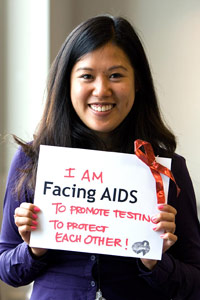You cannot rely on symptoms to know whether you have HIV. If you have symptoms, they may be caused by something else. And many people infected with HIV have no symptoms for many years. In fact, one in five U.S. women and men infected with HIV don't know they have it. The only way to know whether you have HIV is to get a test.
HIV symptoms
Many people have no symptoms when they first get HIV. Some have no symptoms for years. It varies from person to person. But some people get a flu-like illness within a month or two after first getting HIV. Those symptoms include fever, headache, being very tired, and swollen lymph nodes (glands in the neck and groin). Often the flu-like symptoms go away within a week to a month. Even if there are no signs of sickness, HIV can still be passed to another person.
It's important to remember that HIV is active inside your body, even when you don't have symptoms. As HIV spreads in your body, you'll start to feel sick. For many people, the first symptom they notice is large lymph nodes (swollen glands) that last for more than three months. Other symptoms of HIV include:
- Being very tired (fatigue)
- Quick weight loss
- Fevers and night sweats
- Headache
- Diarrhea, vomiting, and nausea
- Mouth, genital, or anal sores
- Dry cough
- Rash or flaky skin
- Short-term memory loss
There are also other health problems that are more common, serious, and harder to treat in women with HIV:
- Vaginal infections, like yeast infections and bacterial vaginosis
- Sexually transmitted infections (STIs) like gonorrhea, chlamydia, and trichomoniasis
- Pelvic inflammatory disease (PID) that does not respond to treatment
- Pnuemonia
- Human papillomavirus (HPV) infections, which can cause genital warts and cervical cancer
- Other opportunistic infections (OIs) that can affect the eyes, digestive tract, kidneys, lungs, skin, and brain
More information on HIV symptoms
Explore other publications and websites
-
Basic Information About HIV and AIDS — This Web page describes what HIV looks like, its history, how it is transmitted, symptoms of HIV infection, where to get tested, and other basic information about the virus.
http://www.cdc.gov/hiv/topics/basic/
-
HIV and AIDS: Are You at Risk? — This brochure explains what HIV/AIDS is, how to know if you have it, what testing is done, and how to protect yourself from becoming infected.
http://www.cdc.gov/hiv/resources/brochures/at-risk.htm
-
Living With HIV/AIDS — This booklet is for people who are HIV-positive. It can help you and your loved ones understand HIV and its effects on health and everyday life.
http://www.cdc.gov/hiv/pubs/brochure/livingwithhiv.htm
-
Signs and Symptoms — Many people do not know they have HIV. This Web page gives the signs and symptoms some people may experience during early stages of HIV infection.
http://aids.gov/hiv-aids-basics/hiv-aids-101/overview/signs-and-symptoms/
-
Understanding HIV/AIDS — This Web page provides an overview of HIV, how HIV causes AIDS, and the HIV lifecycle. It has information about symptoms, diagnosis, treatment, prevention, and current research on HIV.
http://www.niaid.nih.gov/topics/hivaids/Pages/Default.aspx
Connect with other organizations
-
AIDS.gov
http://www.aids.gov/
-
AIDSinfo
http://aidsinfo.nih.gov/
-
American Social Health Association
http://www.ashastd.org/
-
Centers for Disease Control and Prevention, HHS
http://www.cdc.gov/
-
Divisions of HIV/AIDS Prevention, CDC, HHS
http://www.cdc.gov/hiv/dhap.htm
Content last updated July 1, 2011.
Resources last updated July 1, 2011.
womenshealth.gov
A federal government website managed by the Office on Women's Health in the Office of the Assistant Secretary for Health at the U.S. Department of Health and Human Services.
200 Independence Avenue, S.W. • Washington, DC 20201


 Text size
Text size Email
Email

